
![]()
Index • |
Welcome • |
About
Us • |
21st Century • The Future |
World
Travel • Destinations |
Reviews • Books & Film |
Dreamscapes • Original Fiction |
Opinion
& Lifestyle • Politics & Living |
Film
Space • Movies in depth |
Kid's
Books • Reviews & stories |
The International Writers Magazine: Nepal
Tharu Culture in Turmoil: Sauraha, Nepal
• Scott Maier
Photos by: Scott Maier
Nepal has been civil war-free for exactly one year. While this is progress to be sure, it hasn’t mitigated the accompanying cultural and social strife, including skirmishes, random violence, strikes, and blockades of important resources to the capital, Kathmandu, such as petrol.
These problems have caused continued devastation to the main industry in Nepal: tourism. While the end of the civil war brought a resurgence of revenue from visitors, the lack of stability acts to effectively limit the recovery. Chitwan National Park, after Kathmandu itself, is the next major tourist destination in all of Nepal, and therefore particularly sensitive to the wavering instability in the region. The resulting tension is pervasive, but as it turns out, difficult to classify, and almost impossible to hold any one source accountable for. However, this fact doesn’t stop the desperately strained residents of the Chitwan region from attempting to find a blameworthy entity, and violence here has transcended political ideologies into a regional ethnic struggle.
After a two week closure to discourage further violent protests in March of this year, Chitwan National Park re-opened, but only for tourists, on Sunday, the fifteenth. I boarded a bus early on Monday for a six hour drive through the mountains and into the Terrai region, where the sub-Himalayan ranges give way to lush floodplains. The landscape here is a vast expanse of flatness in every direction, and the hilly terrain that defines central Nepal ends abruptly and emerges into rice, corn, wheat, mustard, and marijuana fields which are in turn dotted intermittently with towns, villages, or groupings of huts. The largest dominant ethnic group in the region is the Tharu people, one of the longest living cultures still present in Nepal today.
The protests, which resulted in several deaths, including one police official and two protesters, was sparked by a set of controversial ordinances passed by Prime Minister Pushpa Kamal Dahal after the closing of the formal legislative session of the National Assembly in early February. Three relatively benign ordinances unilaterally passed outside of normal democratic processes, and under the guise of time sensitivity, upset several political groups, including both allies and opposition to the CPN (Maoist) party, which Dahal heads. Most notably, the Nepali Congress, main opposition to the Maoists, called the move a direct threat to the peacemaking process and voiced its harsh disagreement with the bold move. Among the finer points of the speedily passed legislation was a section which classified the Tharu people under the umbrella term ‘Madhessi,’ another ethnicity which inhabits the Terrai. Rather innocently enough, the Dahal government was using this blanket terminology in an attempt to simplify the diverse region for purposes of public works and infrastructure implementation, but just one month later, on March sixth, The Tharu population in Chitwan organized and implemented a strike barricading all traffic, setting several vehicles ablaze, and demonstrating in the streets. Police and locals clashed on several occasions during the thirteen day struggle. The Tharu people saw the government ordinance both as outside of constitutionally granted authority, and as an attempt to formally reclassify and effectively eliminate an entire ethnic population. There is a glimmer of truth to both of these statements; although without a formal and permanent constitution, the remedy is far from transparent. The fact that the ordinances were passed without consulting the National Assembly also provides measurable difficulty in settling the dispute expediently and to the satisfaction of all groups.
The Tharu community desires and deserves to preserve its culture, and should expect legitimate recognition from state apparatuses. However, the Dahal government, which depends rather heavily on its alliance with several Terrai-based Madhesi groups for majority and legitimacy in the National Assembly, cannot afford to alienate the Madhesi population by unfavorably altering the ordinances which were passed by the hand of Prime Minister Dahal himself. Actions and alterations such as these have overtones of authoritarian power which no party will be willing to tolerate after nearly six decades of struggle for legitimate democracy in Nepal, including ten years of bloody civil war.
After nearly two weeks of violence, riots, and a curfew at dusk, a six point agreement was signed between the agitators and the government negotiations team, which was somewhat ignorantly headed by a high ranking Madhessi politician. Among the points stipulated in the pact, the government has agreed to change the terminology of the ordinance to respect the Tharu and other ethnic identities in the Terrai who are not Madhesi. Also, the protesters who were killed have been declared martyrs and compensation will be provided for the deceased and all injured protesters. Free medical treatment will be provided as well. However, the Tharu groups are still upset about terminology within the interim constitution itself, which similarly terms Tharus and others as Madhesi. Madhesi groups, in contrast, which were important to the ruling coalition in maintaining legitimate majority, have said unequivocally that they would ‘hit the streets’ if the Madhesi identity were challenged in any way. The Madhesi party leadership sees the current Tharu movement as an attempt by the Tharu people to neutralize the Madhesi movement which secured certain rights for themselves.
With the conflict, demonstrations, and violence confined to the larger towns along the paved roads, the smaller villages near the National Park where tourists flock and hotels thrive were glad to have business open up again after the two weeks of isolation. The town felt like a nervous graveyard shift of former glory. There were hotels on every street and every corner, but each had only one or two guests. Some had none. Business here hadn’t been quite the same since the Maoist insurgency deterred all but the most resolute international travelers. There were shops selling souvenirs and also small snack shops, but mostly they just bought cigarettes and coffee from each other. This small village called Sauraha was populated by more western and Japanese tourists than I had seen even in Kathmandu, and the hotel owners and shopkeepers seemed weary, disappointed, and spent as they catered to the western sentimentalities that came with the tourists’ money. I felt strange to be a part of this economic cycle, I felt a bit imperialistic, but I was a tourist, and this is how it works here. After three days of walking, canoeing, and riding in a jeep and on an elephant through the jungle we were supposed to head home to Kathmandu to the noise and confusion of the big city. I woke up Thursday morning at eight o’clock and came outside to find our host and owner of the Chitwan Jungle Camp and Lodge explaining that there was a strike and we would have to stay for an additional day.
There was a bus burning in the street seven kilometers away and I grabbed my camera and a bicycle and took the dusty roads through the paddies and past the river, over the bridge and through the suburban villages close to town. I emerged onto the paved road to find the wrecked minibus extinguished. Groups of still-energized students and adults walked up and down the street. No cars were on the large east-west highway, a transport truck was melted to the street by its tires a few hundred yards away, and glass from the windows of the minibus was smashed intermittently down a stretch of a quarter mile of street; evidence of the slow capture of the unfortunate vehicle.
The minibus in town was burned crisp. Skeletal springs from the seats and various metal joints and components were left supporting the blackened weight of the vehicle. A few dozen people were poking their heads inside to see the completeness of the fire’s destruction, and a large group of twenty-year-olds told me politely but forcefully that I was not to take any more pictures, so I made myself obscure. The bus and truck had been stopped and lit at around four in the morning for the strike that day which was to protest local elections, which are perennially strong-manned by Maoist cadres. Apparently still energized from the violence only a week before, this second strike illustrates the range of grievances of the Tharu people. Despite the bold display of burning vehicles, this protest was scheduled for one day only. No police were involved, and it lasted just that one day.
The rest of Thursday was spent in a jeep on the straightest road I have ever seen. The dusty pair of parallel tracks followed a river into the vanishing point for more than twenty miles. Several collective village efforts were being made along the way to dam up the flow for fishing and irrigation. When we returned we went straight back into the jungle to where we had entered on the first day; to where the wildlife viewing tower was located in a gap in the trees between two large fields. This tower had three rooms for guests, and we were sharing our flat-for-the-night with an Australian couple. We went for a short walk before the light faded in an attempt to see rhinoceros in the murky pond which we were successful in doing. After returning, our guides joined the requisite park guides that accompany all parties into the forest in the one room on the lower level to cook dinner, drink, and smoke local cigarettes.
After a couple of drinks of ‘Nepali Paani,’ or Roksi, the locally made spirits distilled from rice and millet, the owner of our lodge, Chandu Tharu, began to apologize for the highly inflated price we had just paid for chocolate and drinks at the trail head. He was genuinely embarrassed and upset at the incident, although we hadn’t made a big deal out of it or even really registered it. He explained that if the vendor were a man he would have had words with him. I accepted his gift of a Snickers bar which he had bought for one quarter what it would have cost me, and he broke character as a knowledgeable and jovial wilderness guide and earnestly continued to explain the devolution of Tharu culture in the area within the last fifteen years. At the time the park was formed by the government of Nepal, tourists could stay in Sauraha and see the jungle, but in the smaller Tharu villages one would be hard pressed to find paper, or even a plastic bag. Western amenities would have been impossible to locate. It was natural and it was authentic. What he saw now in his daily work, in his opinion, was Tharu villagers intent on making elevated funds from glassy-eyed westerners in the manner in which we had just been over charged. Just enough extra that the profit is immense in local terms, but just low enough that slow tourist currency conversion math doesn’t immediately cancel the deal. Chandu was discouraged and offended by this behavior, although I wondered if the ‘junglee marijuana’ habbit he sported was also a product of westernization and catering to western vices, or if that was a compulsion he developed on his own. His whole staff smoked junglee, as he called it, and his moment of candor was almost certainly influenced in part by its effects. The honesty in his voice, however, conjured understanding of the economics of the area. The quickest money was to package and sell Tharu culture as well as eastern impressions of western comforts to well-dressed, well-equipped, well-paying gawkers. I felt a little sick, and torn without a doubt as to just what I was doing in Nepal, what I was doing here in the jungle providing money for private sentimental ownership of a piece of the slowly disappearing Tharu culture.
Observation, no matter how scientific in procedure, not that tourism is scientific necessarily, invariably alters whatever is being observed. In Sauraha this was painfully evident. Culture isn’t precise, and tourists aren’t either, but the process still works the same. Each guest comes for a small piece of the jungle, and leaves behind them a small shred of influence; a residue of personal contact on each person they meet. Over time this process changes culture and its authenticity. After all, a tourist keeps the memory of just one visit while on the other hand, a local culture being visited experiences a constant barrage of widely ranging ideas, attitudes, needs, and social habits.
The crux of the issue, preservation of Tharu culture, is more than conflict between local identity and a government decision, or terminology in an interim constitution. It is a battle between modernity and tradition. The ordinance and constitution just happen to be the only tangible manifestations of tensions that are otherwise psychological and generational. Especially in a country where just fifteen years separates the current infant democracy from a partly-less monarchy system of government, extreme tradition and high-paced development are at constant odds and sentimentalities of both are present in the old and new generations. Fast track democracy and development to capitalist industry forces people of all ages to identify either with the past or the future, and when this occurs within and between younger generations still interested and capable of protest and violent struggle, the outcome can be explosive as was the case in Chitwan this month, and is the case still in many regions of Nepal.
© Scott Maier August 2010
thinkersplayground3@gmail.com



